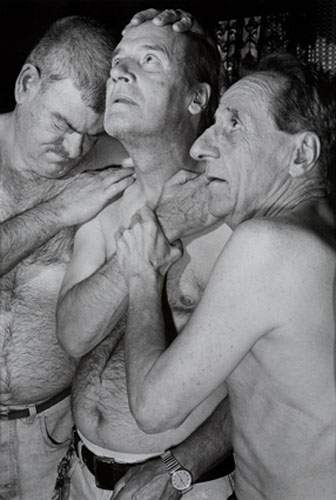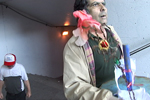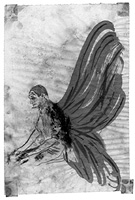Donigan Cumming: Oeuvres Récentes (Donigan Cumming, 2003 - 2009) *Director in Attendance
**** (Masterpiece)

The screening of Montreal documentarian Donigan Cumming’s recent oeuvre at the Cinémathèque Québécoise,in the Salle Claude Jutra, on Wednesday March 17th has been eagerly anticipated, met its expectations, exceeded them and was so exasperatingly original that you wished there were more films. Donigan introduced the screening and you could recognize his familiar voice and face from his earlier works. He is also taller then you would imagine. The screening from a high quality Blue-ray disc included Locke’s Way (2003), Cold Harbor (2003),

Outside the screening hall there is Cumming’s photograph exhibit Kincora 2010. The exhibit Kincora includes the framed photographs Barber’s Music (Ottawa, 1999), Les Pleureurs (which accompanied the video installation of A Prayer for Nettie, 1995), Lying Quiet and a few mixed-materials Kincora sketches. Donigan writes about it:
“The title of this exhibition refers to a street in downtown Montreal that was erased by developers in the late 1980s, destroying a little neighborhood and scattering its residents across the city and suburbs. Nothing was ever built on the site. It remains an urban wasteland, a parking lot. Most of the people who lived there are now dead."The show will be on display in the Foyer Luce-Guilbeault until March 28th.

Locke’s Way is an epistemological rumination on Donigan’s older brother Julien through a photographic analysis. Donigan speaks out his train of thought as he goes through one picture to the next. Locke’s Way is and apt start to the retrospective as it presents the end of Cumming’s early video period (1995 – 2003), which is available on the DVD set Controlled Disturbance. Similarly to how Cumming's A Prayer for Nettie (1995) presented the end, or at least a transition, from photography to video. Cumming’s photographic publications up to that point included Reality and Motive in Documentary Photography (1986), The Stage (1991), and Pretty Ribbons (1996). The transition from photography to video was highlighted by a decreased sample size and increased attention to the minutia details of his participants and the spontaneity of their collaboration.

Locke’s Way deals with larger philosophical and political issues. An immediate philosophical reference is to the British empiricist John Locke who posited that all knowledge arises from sensory experiences. Locke’s Way also evokes the process of memory and the act of recollection as Donigan looks and thinks about the table full of photographs. Though he tries repeatedly to escape this activity by running up the basement stairs to get away from the memories, he is only able to find that upstairs there are his brother Julien's old medical reports. Julien, the subject of Locke’s Way, seems to represent a repressed subject for the filmmaker and the descent into the basement physically illustrates this concept of delving into the unconscious. There are two photographs of Donigan hidden in the mess. One is a childhood portraiture in a family collection and the second is at a wedding and Donigan is wearing a black suit with dark sunglasses. The film deals with biopolitics - Michel Foucault's term for the style of political power that regulates all aspects of human life - as it is the government policy that deems Julien as unfit. Julien was deemed “mentally disabled” at a young age by the government. His mother and grandmother worried about how his presence would affect his siblings. This is akin to Robert Zajonc’s confluence model, which suggests that children are born into intellectual environments that affect their intelligence. While Donigan is reflecting on these issues, he is also being affected by biopolitics as he runs around his house. This process of running up-and-down stairs directly alternates Donigan’s physiology, how he communicates, and the audio-track through Donigan’s heavy breathing. If you look closely at the edge of the steps when Donigan is moving there are signs of fading on the stairs. The edge of the stairs are missing paint and are grooved. This detail in the mise-en-scène extends the themes of frailty, timeworn, and decrepitness. Finally As Donigan looks over the pictures the audio-track fast-forwards and then slowdowns coming to a creeping close on a picture of Julien.

Cold Harbor is a 3-minute short-film about an ill African-Canadian decrepitly breathing with off-screen voice-over narration reciting facts about the American Civil War (1861 – 1865) and it ends with a radio news report on the Iraq war. The American Civil War was a prominent subject in Donigan Cumming’s childhood growing up in the United States. Fountain is the accumulated video-footage from the earlier videos and photograph with some unseen footage. It is an eulogy for all his past-collaborators (e.g., Pierre, Julien, Gerry, Marty, Nettie, etc) and examines his old friends from multiple perspectives varying from bodily close-ups, to their rooms, neighborhoods, and their reciprocal relationship. This video footage had been also used for the book and grid collage Lying Quiet that was produced with Peggy Gale for the Museum of Contemporary Canadian Art. It interesting to see the footage that had not yet been released and in it Donigan creates a visual bricolage of live-action and photographs. 3 is interlaced with a lot more intertitles then his previous work. The intertitles include: men asleep, a dream, play, a song; angel and snow, wings and flowers, money and trees; fast then slow, piano decays, laughter. The intertitles and the scenes present dualities that sometime contradict one another. One scene that particularly stands out is an exchange of money between the hands of Donigan and a collaborator where he exposes the monetary transaction side of his film-making while presenting a beautiful image of a green grass and trees background. Untitled, A.K.A. Pencils, Ashes, Matches, Dust, is a commissioned “film haïku” for Visions du Réel International Film Festival in Nyon, Switzerland.
 The two most interesting films in the series were Monument and Too Many Things. They represent very transitional works in Donigan’s career. These unexpected illustrations show Donigan’s films in a post-Nettie-Collin-Colleen-Pierre-Albert-Nelson world. There is the passing of an era and the resurrection of another for a new decade.
The two most interesting films in the series were Monument and Too Many Things. They represent very transitional works in Donigan’s career. These unexpected illustrations show Donigan’s films in a post-Nettie-Collin-Colleen-Pierre-Albert-Nelson world. There is the passing of an era and the resurrection of another for a new decade.Monument starts with Donigan kneeling down naked in a white room, he crushes a statue of a flower, there is a quick cut to Julien waking up, and then a sunrise on the water. The strange flower sculture is passed around and people are mourning. In the video interview “Visions du Réel, Atelier with Donigan Cumming” Donigan is critiqued for documenting others instead of himself. In Monument Donigan brings himself more directly into the picture. He creates an angst-ridden portraiture of himself destroying the symbolic flower. Nakedness in art history represents simultaneously a symbol and a true identity. Also while interviewing the new collaborators Donigan implements his presence more as he reflects himself in a mirror and his discussions with his collaborators showcases the slow process of building trust with an unreceptive participant. In Donigan's friendship with his old participants there was a mutual understanding that Donigan guided the behavior and controlled their actions. Now, when Donigan guides the new collaborators, such as asking them to put the destroyed statue in a fridge, there are these moments of hesitancy and ridicule. As if they are surprised to perform such a task. This could possibly be the result of the interviewees temperament or how many takes Cumming’s chose to film.
In Too Many Things, which was produced during Donigan Cumming's 2008 - 2009 artist residency at the Productions Réalisations Indépendantes de Montréal (PRIM), there is such an overabundance of creativity and celebration that the excitement leaks out of the frame. Now that Cumming’s has a firmly established palette and a distinct visual style which includes the socially assisted poor, his Mini-DV mobility, images with an abstract quality, useful trivia, slow-motion, and songs. He can abstractly present these issues through visual stand-ins. The narrative follows Ross (who looks strikingly similar to the late Éric Rohmer) and his friends during their routine weekday two-hour visits to the Salvation Army (880 rue Guy) where they hang out and look at the assortment of objects. They enjoy each others companionship and they incomprehensibly babble on top of each other in a Altmanesque fashion. There are breaks in the narrative for a stop-motion waterpaint-infused dissection of a CPU and Kincora moth-like sketches filling the frame. Where earlier on in his career Cumming’s was investigating the underrepresented now it is the underrepresented examining discarded household objects with the same magnifying precision.
Fountain presents an eulogy for his past-collaborators, in Monument Donigan works through his frustrations, and in Too Many Things there is a rejuvenation. This retrospective showcases Donigan Cumming as an ever-evolving artist who is fully aware and interested of pursuing his career to the brink. He is experimenting with different approaches, meeting new participants and building an evolving body of work. He is a constant extender of the Canadian documentary tradition and now he is also appropriating the NFB animation sector with his use of stop-motion. The theatrical programming really added a narrative to the works and I eagerly anticipate his future endeavors.-David Davidson

No comments:
Post a Comment